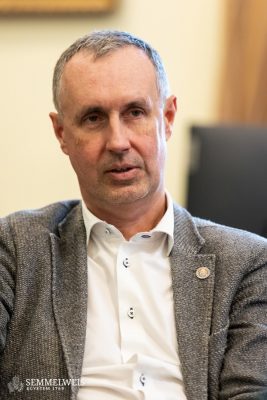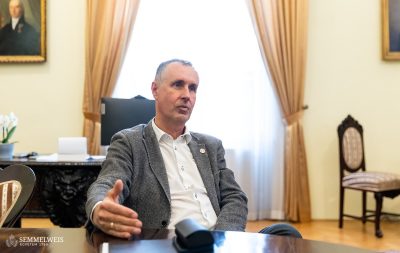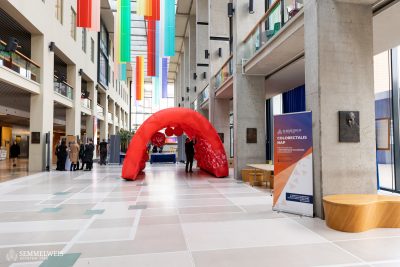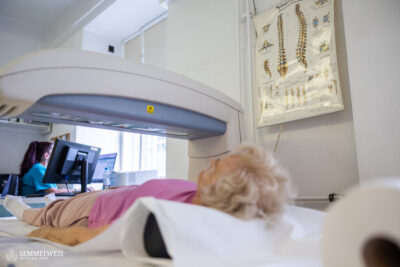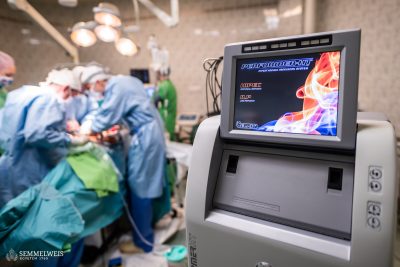“Based on the decision of the Senate, a large paediatric institute was created from the two Departments of Paediatrics on January 1.We asked Dr. Attila Szabó to lead the integration and to head the institution merged with the Tűzoltó Street department,” Dr. Béla Merkely, Rector of Semmelweis University said. “The merger will not change the existing teaching structure, the two heads of the former departments, Dr. Attila Szabó and Dr. Gábor Kovács will hold their position. The integration is primarily aimed at optimizing management, governance and economic processes, eliminating duplication, making optimal use of infrastructural resources and developing a unified paediatric practice,” he added.
“Both children’s hospitals have already been working to an outstanding standard and the merger is expected to further improve their performance. The move will also alleviate the human resource shortage that is a challenge in the health sector, especially the shortage of specialist staff, strengthen patient care and expand the potential of education and research,” the rector stressed.
“The integration will further develop the Tűzoltó Street unit, which plays a unique role in paediatric haematology, oncology, immunology and rheumatology. The streamlining of professional profiles, the reduction of duplications, the development of human resources and infrastructure all serve the aim of strengthening the functions of both departments of the clinic and making it a leading paediatric centre at regional level,” Dr. Béla Merkely pointed out.
In connection with the integration, Dr. Gábor Kovács, former head of the Tűzoltó Street department confirmed that the two departments had done high quality work separately, and the new centre created by the merger could become Europe’s leading paediatric institute. On the issue of human resources, he said: “Providing them is a major problem, one that we also have serious difficulties with, but it is up to us to solve it if we work together.”
“Rationalizing the clinical structure and reducing duplication has been a long-standing process at the university, and the merger of the paediatric clinics is the latest step. The integration, whose advantages and disadvantages have long been known, and which has a long tradition at the university, was justified not only by internal reasons but also by external factors such as COVID,” Dr. Attila Szabó, head of the former Bókay Street Unit, the university’s Vice-Rector for Clinical Affairs and the President of the Clinical Centre, told our website. “A partial rationalisation of the paediatric departments has already taken place in 2007, when the specialized care was established,” he added.
As a result, the Bókay Street unit is now the national centre of excellence for premature, neonatal and infant care, as well as renal and hepatic care, while the Tűzoltó Street unit has traditionally focused on paediatric oncology, paediatric haematology and, more recently, paediatric rheumatology. “At the same time, there are still duplications and there is still room for streamlining the system professionally, while at the same time improving professional quality,” Dr. Attila Szabó explained. By treating the institution as a single clinic, we have much more scope to cultivate certain specialties at a higher level or even to bring in new ones. A common HR management, belonging to one department, makes the distribution of tasks easier and more rational. With integration, all the specialists in a given area are involved in the work of both departments, which is more beneficial for patients than the previous practice of two independent clinics providing patient care,” he emphasized. Dr. Attila Szabó cited an example: before the integration, an infectology consultant was transferred to Tűzoltó Street when needed, but with the merger, all six infectology specialists working in Bókay Street, with different specialisations, are available in both departments. “There could be more flexibility in the organisation of patient care in several specialties, which could give colleagues more scope for greater involvement in education and research.” he pointed out.
According him, more scope for professional training is also an advantage. So far, both departments have insisted that residents and trainees spend more time in their own “training site”, but now they will have a better overview of the whole paediatric clinical care,” the director said. There is, of course, a reasonable limit to rationalization and reduction of duplication. A hundred percent specialization is of course not possible, and for care with a high level of progressivity, such as the treatment of liver patients in Bókay Street, children’s plastic surgery, or haemato-oncology patients in Tűzoltó Street, other specialists such as gastroenterologists, endocrinologists or neurologists are needed on site, but this does not mean that large departments should be maintained in parallel – instead, the capacity to provide care is needed at both sites,” he stressed.
“The integration will also make it easier in HR management and recruitment, especially in the case of professional staff, as the department will offer greater choice to candidates, as it will operate in two departments, offering different micro-environments, infrastructure and colleagues,” the director noted. In addition to cleaning up professional areas and HR management, the institution can also be more efficient in terms of management if the same types of orders are managed jointly. A further opportunity is the joint development of the technical field, and the joint and cost-effective solution of technical problems that are often common.
Dr. Attila Szabó also expects a lot from the transfer of good practices. As examples, he mentioned the cleaning system introduced in Bókay and the IT development in Tűzoltó Street, both of which he considers worthy of being introduced in the other department.
Dr. Attila Szabó, who has been the head of Bókay Street unit for almost 10 years, spends two days a week in Tűzoltó Street and two in Bókay, and on Fridays he tries to be present in the departments. As he said, he considers it important to be present, he does not want to run the institution from behind a desk. Where he is present, he conducts a medical meeting in the morning, makes ward rounds, and considers the teaching of sixth-year students and postgraduates there to be particularly useful. As he said, he tries to be present in every department. And he relies on his experienced colleagues for leadership.
It’s not a one-man show, I’m just one of many colleagues, although obviously I’m the one who has to see things through and set the direction for the department, but it’s a team effort,”
Dr. Attila Szabó emphasized.
As he said, he will run the new, merged institution in a similar way and in a similar manner as he has run Bókay. “We need very good doctors and excellent staff,” he stressed, mentioning the program launched at Bókay a few years ago to increase staff satisfaction and staff numbers, which he also considers worth expanding. In addition to the classic triad of patient care, education and research, he would also pay great attention to improving the first impression of those entering the clinics and to standardising the principles and expectations in this regard. In the first year of integration, he expects a lot of hard work but after that the results will show, he said, adding that it will take years to create a unified ethos
“In terms of patient pathways, we still need to think about where the focus should be in some areas” to reduce duplication, but there are areas where the measure is already having a positive impact. More patients have already been transferred from the previously overburdened paediatric emergency department at Bókay to Tűzoltó Street, making the allocation more rational, which is certainly a positive result for patients,” the director stressed.
At the end of the interview Dr. Attila Szabó emphasized: he believes that the Department of Pediatrics, with its history, professional background, and care covering almost the entire pediatric portfolio, can become a leading pediatric, educational and research institution not only in Hungary, but also in Europe.
The Director invites everyone to work together with a quote from Gabriel Garcia Marquez: “I have learned so much from you men…. I have learned that everybody wants to live at the top of the mountain without realizing that true happiness lies in the way we climb the slope.”
Anita Szepesi
Translated by Rita Kónya
Photo: Attila Kovács – Semmelweis University
